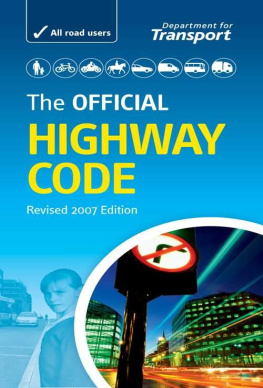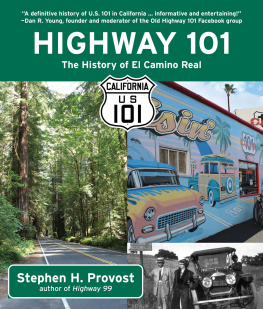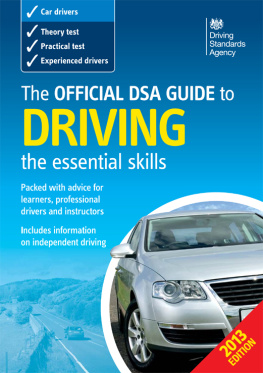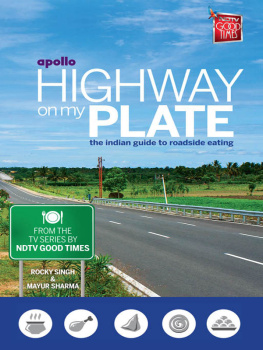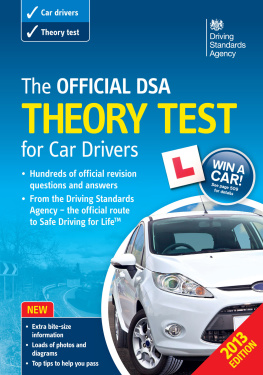The OFFICIAL
HIGHWAYCODE
Prepared by the Driving Standards Agency for the Department for Transport.
Crown copyright 2007
You may re-use this document/publication (not including the Royal Arms and other departmental or agency logos) free of charge in any format for research, private study or internal circulation within an organisation. You must re-use it accurately and not use it in a misleading context. The material must be acknowledged as Crown copyright and you must give the title of the source document/publication.
Where we have identified any third-party copyright material you will need to obtain permission from the copyright holders concerned.
This document/publication is also available at direct.gov.uk/highwaycode
For any other use of this material you will need to be aware of the terms of the Open Government Licence, which are explained at nationalarchives.gov.uk/doc/open-government-licence/
The publication of facsimile versions of this publication or any other versions that closely resemble the style and appearance of the original may confuse the public. Any publisher wishing to reproduce the content of this publication should not replicate the official versions style and appearance. Other versions should not be presented as being an official version.
First published 1931
Fifteenth edition 2007
Thirteenth impression 2011
ISBN 978 011 553177 4
The Driving Standards Agency is an executive agency of the Department for Transport. The Department for Transport and the Driving Standards Agency recognise and value their customers. We will treat all our customers with respect and deliver our services in an objective, polite and fair way.
Contents
Introduction
This Highway Code applies to England, Scotland and Wales. The Highway Code is essential reading for everyone.
The most vulnerable road users are pedestrians, particularly children, older or disabled people, cyclists, motorcyclists and horse riders. It is important that all road users are aware of the Code and are considerate towards each other. This applies to pedestrians as much as to drivers and riders.
Many of the rules in the Code are legal requirements, and if you disobey these rules you are committing a criminal offence. You may be fined, given penalty points on your licence or be disqualified from driving. In the most serious cases you may be sent to prison. Such rules are identified by the use of the words MUST/MUST NOT . In addition, the rule includes an abbreviated reference to the legislation which creates the offence. An explanation of the abbreviations is on .
Although failure to comply with the other rules of the Code will not, in itself, cause a person to be prosecuted, The Highway Code may be used in evidence in any court proceedings under the Traffic Acts (see ) to establish liability. This includes rules which use advisory wording such as should/should not or do/do not.
Knowing and applying the rules contained in The Highway Code could significantly reduce road casualties. Cutting the number of deaths and injuries that occur on our roads every day is a responsibility we all share. The Highway Code can help us discharge that responsibility. Further information on driving/riding techniques can be found in The Official DSA Guide to Driving - the essential skills and The Official DSA Guide to Riding - the essential skills.
Rules for pedestrians |
General guidance |

| Pavements (including any path along the side of a road) should be used if provided. Where possible, avoid being next to the kerb with your back to the traffic. If you have to step into the road, look both ways first. Always show due care and consideration for others. |

| If there is no pavement, keep to the right-hand side of the road so that you can see oncoming traffic. You should take extra care and be prepared to walk in single file, especially on narrow roads or in poor light keep close to the side of the road. It may be safer to cross the road well before a sharp right-hand bend so that oncoming traffic has a better chance of seeing you. Cross back after the bend. |

| Help other road users to see you. Wear or carry something light-coloured, bright or fluorescent in poor daylight conditions. When it is dark, use reflective materials (e.g. armbands, sashes, waistcoats, jackets, footwear), which can be seen by drivers using headlights up to three times as far away as non-reflective materials. |

Rule 3 Help yourself to be seen

| Young children should not be out alone on the pavement or road (see ). When taking children out, keep between them and the traffic and hold their hands firmly. Strap very young children into push-chairs or use reins. When pushing a young child in a buggy, do not push the buggy into the road when checking to see if it is clear to cross, particularly from between parked vehicles. |

| Organised walks. Large groups of people walking together should use a pavement if available; if one is not, they should keep to the left. Look-outs should be positioned at the front and back of the group, and they should wear fluorescent clothes in daylight and reflective clothes in the dark. At night, the look-out in front should show a white light and the one at the back a red light. People on the outside of large groups should also carry lights and wear reflective clothing. |

| Motorways. Pedestrians MUST NOT be on motorways or slip roads except in an emergency (see ).
Laws RTRA sect 17, MT(E&W)R 1982 as amended, reg 15(1)(b) & MT(S)R reg 13 |
Crossing the road |

| The Green Cross Code. The advice given below on crossing the road is for all pedestrians. Children should be taught the Code and should not be allowed out alone until they can understand and use it properly. The age when they can do this is different for each child. Many children cannot judge how fast vehicles are going or how far away they are. Children learn by example, so parents and carers should always use the Code in full when out with their children. They are responsible for deciding at what age children can use it safely by themselves. |
A First find a safe place to cross and where there is space to reach the pavement on the other side. Where there is a crossing nearby, use it. It is safer to cross using a subway, a footbridge, an island, a zebra, pelican, toucan or puffin crossing, or where there is a crossing point controlled by a police officer, a school crossing patrol or a traffic warden. Otherwise choose a place where you can see clearly in all directions. Try to avoid crossing between parked cars (see ), on a blind bend, or close to the brow of a hill. Move to a space where drivers and riders can see you clearly. Do not cross the road diagonally. |

